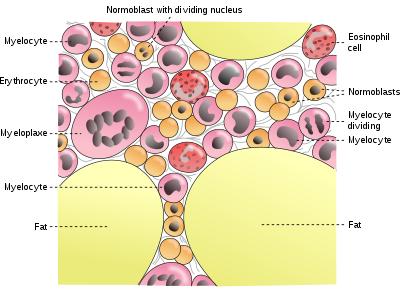30 000 billion red blood cells
Why such a large proportion of iron is needed for hemoglobin? It is evident with the number of red blood cells in the body. Every second, the human body produces about 2 million red blood cells. If you were to pull out all the red blood cells (30 000 billion) from a man and arrange them in a row or a thread, it could be wrapped for five times around the equator.

Iron distribution in the body
Overall, the iron distribution in the body is as follows:
Hemoglobin 67 per cent
Iron stores (depot iron) 27 percent
Myoglobin (oxygen carriers in Muscle) 3.5 percent
labile iron storage (serum iron) 2.2 percent
iron-containing enzymes 0.2 percent
Reserve iron
It is mostly through the storage proteins ferritin and hemosiderin. With an increased need for iron, hemoglobin is also increased, iron storage proteins of hepatocytes and macrophages in bone marrow, liver and spleen are enhanced.
Iron is involved in many processes
Iron is absorbed as divalent iron in the duodenum and from there into the blood. There, it is in the trivalent form, bound to the protein transferrin. In the bone marrow, transferrin binds to the erythroblasts, which are equipped with specific receptors and the iron in hemoglobin can be transported to the site. Old red cells are removed by macrophages. A portion of the iron is released from hemoglobin and is again bound to transferrin, to be recycled. The other part of the iron remains as storage iron (ferritin or hemosiderin) in macrophages and can be stored there and mobilized again if necessary. The iron excretion of iron from the organism can be via the exfoliation of cells of the inner and outer surfaces of the body with the stool, urine and sweat. For men, it is between 0.5 and 1 mg per day. In menstruating women, with menstrual bleeding, about 20 mg of iron is lost per month. On these values, the iron excretion can be increased even further.
A healthy diet has about 30 mg of iron a day, the small intestine can only take 10 to 20 percent, or about 3 mg. Every day the body loses iron as well, for example, through the skin, kidney and intestine . These losses are normal for men(1 mg) and about 3 mg in women. Healthy and varied diet can, therefore, compensate for the normal daily losses of iron. Increased iron losses can often not be replaced by food completely. In plant foods, iron is in trivalent form in animal food, it is in grade two-form. Trivalent iron has to be converted into two-valent iron before it can be absorbed by the intestinal cell. For this reason, plant food is very mucc vital for the iron supply of the body. Large amounts are needed to cover the daily needs of iron.
Vitamin C increases the absorption of iron from food
By simultaneous absorption of vitamin C as stated at www.anatomylessons.com, the absorption rate of iron is increased too, since it reduces iron to divalent iron from trivalent. Another important influence on the availability of iron in food: there are certain inhibitors of plant foods. These include polyphenols in tea or dried fruits and phytane in cereals, nuts and legumes. They bind iron plant in the intestine. Even a cup of black tea with a meal can prevent most of the iron containing plant. Iron from meat and fish is not affected by these inhibitors, however.
No comments:
Post a Comment